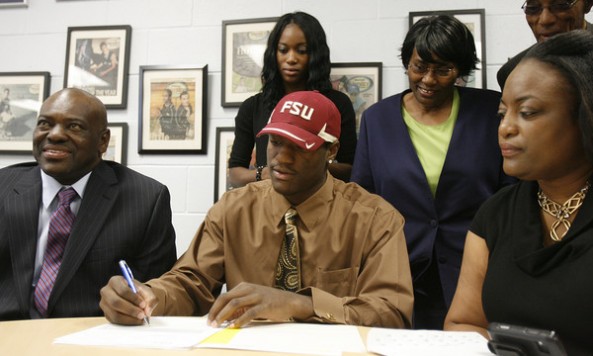In one of the more dramatic finishes of the BCS era, Kelvin Benjamin’s 2-yard touchdown grab against Auburn gave Florida State its first national championship in 14 years. After what some consider a lost decade, Florida State’s rise back to the top of college football was a long, arduous journey. The Seminoles endured three six-loss seasons, an academic cheating scandal and the forcing out of a legend that built the program.
In what will be a 10-part series, we take a look back on events that led to Florida State’s resurgence back to the top of the college football world. After finishing in the top 5 every year from 1987 until 2000, the Seminoles went 13 years without winning a major bowl game. The countdown’s order is mostly chronological rather than in terms of importance. At the midway point in our series, we look at Jimbo Fisher’s first recruiting class as Florida State’s head coach.
The 2009 season had concluded for Florida State with a 33-21 win over West Virginia in the Gator Bowl. The contest would be the last for the legendary Bobby Bowden as the Seminoles’ head man as the baton would be handed to Jimbo Fisher.
With Fisher’s help, Bowden had left the incoming head coach a solid recruiting class to work with, but keeping it in place would not be easy. The prized commitment at the time for Florida State was South Florida defensive back Lamarcus Joyner, who at just 5’8″ and 165 pounds had garnered plenty of national attention while starring at powerhouse St. Thomas Aquinas.
Joyner stuck with Fisher and others would soon follow. On National Signing Day, the Seminoles would ink linebacker Christian Jones, athlete Christian Green and German-born defensive lineman Bjoern Werner.
As great as National Signing Day was for Florida State, keeping prior commitments turned out to be as important for Fisher as Terrence Brooks, Telvin Smith, Mike Harris, Cameron Erving and Kenny Shaw all remained firm in their decisions to attend Florida State. As National Signing Day came to a close, the Seminoles racked up a top 10 national recruiting class and the top class in the ACC.
Fisher’s strong recruiting class didn’t bring about championships immediately, but many of the young players were instant contributors. Jones saw plenty of the field at linebacker while junior college transfer Mike Harris recorded five interceptions in two years in Tallahassee. While the 2010 and 2011 seasons didn’t result in an ACC championship, the Seminoles went 19-8 over that stretch and a perfect 4-0 against rivals Florida and Miami.
In 2012, Florida State would claim its first ACC title in seven years and win its first BCS bowl since claiming the school’s second national championship in 1999. Bjoern Werner had evolved into one of the nation’s premier pass-rushers, finishing third in the nation with 13 sacks. Christian Jones and Telvin Smith made for a very talented tandem at linebacker while Joyner and Terrence Brooks made up half of the Florida State secondary.
The Seminoles closed the 2012 season with a 21-15 victory over Georgia Tech in the ACC Championship and a convincing 31-10 win over Northern Illinois in the Orange Bowl. The strong finish propelled Florida State to its first top 10 finish in nine years and paved the way for a magical run in 2013.
Though Werner declared for the NFL Draft after his junior year, the Florida State defense was as good as it had been in decades in 2013 thanks to a senior-laden core. Brooks and Joyner anchored a secondary that led the nation in interceptions while Smith and Jones made for one of the better linebacker duos in the ACC. All in all, Florida State yielded the fewest points-per-game throughout the entire country.
Cameron Erving and Chad Abram, who each struggled to find reps on defense, switched to the offensive side of the ball and became major contributors. Erving blossomed into one of the premier left tackles in the country while Abram replaced the versatile Lonnie Pryor as the team’s starting fullback. The two unheralded members of Fisher’s first recruiting class helped the Florida State offense put up more points than any other team in FBS history.
After winning their first 13 games in 2013, the Seminoles rallied from a 21-3 deficit to top Auburn to win their first BCS National Championship in 14 years. Down the stretch, members of Fisher’s first class made critical plays.
Abram’s 10-yard touchdown reception in the fourth quarter drew Florida State to within a point of Auburn and after Florida State took the lead with 17 seconds remaining, an accomplished senior sealed the victory. On Auburn’s final play from scrimmage, it was only fitting that the headliner from Florida State’s 2010 recruiting class make the final tackle. As All-American and Thorpe Award finalist, Lamarcus Joyner, ran down Auburn’s Tre Mason from behind, the Seminoles were national champions.
Fisher’s first recruiting class was not his best as far as class rankings are concerned, but it will be forever remembered as the class that brought Florida State full circle. The incoming freshmen in 2010 arrived on the heels of a third 7-6 season in four years and in four years time, it transformed Florida State back into the premier program in college football. For FSU’s return to national prominence, there are a number of reasons. Few however, are as vital as the talent and leadership that head coach Jimbo Fisher brought in with his first recruiting class as head man in Tallahassee.
Related Articles
Reasons for Seminole Resurgence: #7 Emphasizing Defense
Reasons for Seminole Resurgence: #8 Maintaining a Championship Atmosphere
Reasons for Seminole Resurgence: #9 2009′s Strong Finish
Reasons for Seminole Resurgence: #10 Hiring Jimbo Fisher




















